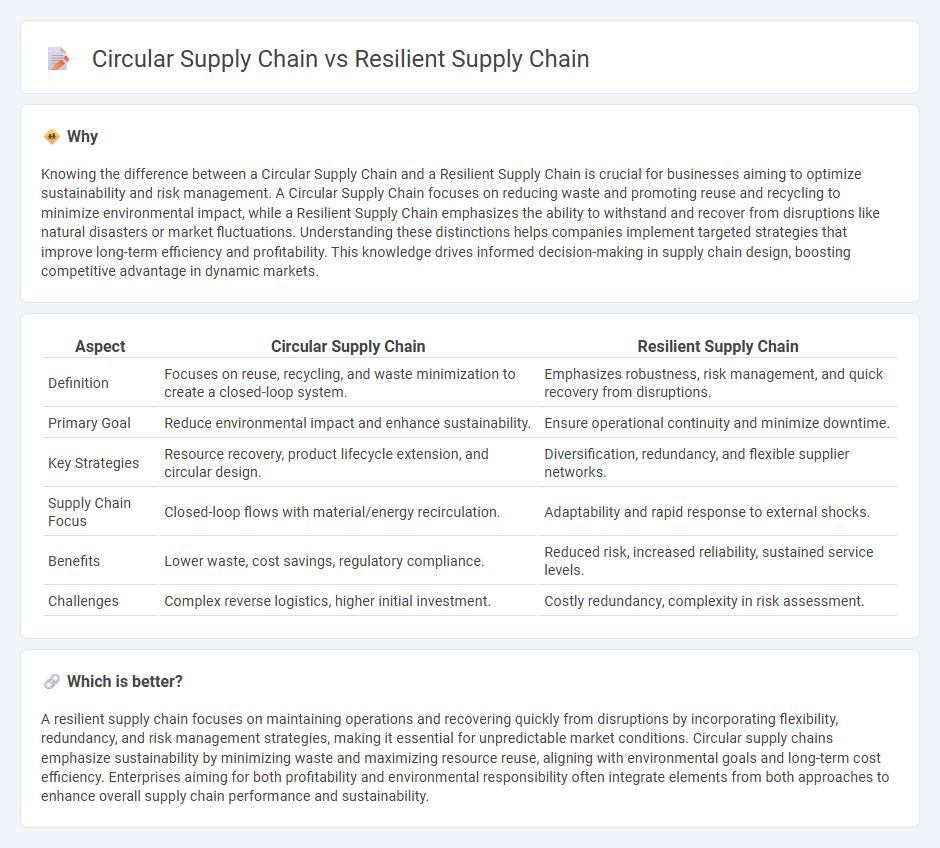
Circular supply chains focus on minimizing waste and maximizing resource efficiency through recycling, reuse, and sustainable design, aiming to create a closed-loop system that reduces environmental impact. Resilient supply chains prioritize flexibility, risk management, and rapid recovery from disruptions such as natural disasters or geopolitical issues to maintain continuous operations. Explore the key differences and benefits of circular and resilient supply chains to optimize your business strategy.
Why it is important
Knowing the difference between a Circular Supply Chain and a Resilient Supply Chain is crucial for businesses aiming to optimize sustainability and risk management. A Circular Supply Chain focuses on reducing waste and promoting reuse and recycling to minimize environmental impact, while a Resilient Supply Chain emphasizes the ability to withstand and recover from disruptions like natural disasters or market fluctuations. Understanding these distinctions helps companies implement targeted strategies that improve long-term efficiency and profitability. This knowledge drives informed decision-making in supply chain design, boosting competitive advantage in dynamic markets.
Comparison Table
| Aspect | Circular Supply Chain | Resilient Supply Chain |
|---|---|---|
| Definition | Focuses on reuse, recycling, and waste minimization to create a closed-loop system. | Emphasizes robustness, risk management, and quick recovery from disruptions. |
| Primary Goal | Reduce environmental impact and enhance sustainability. | Ensure operational continuity and minimize downtime. |
| Key Strategies | Resource recovery, product lifecycle extension, and circular design. | Diversification, redundancy, and flexible supplier networks. |
| Supply Chain Focus | Closed-loop flows with material/energy recirculation. | Adaptability and rapid response to external shocks. |
| Benefits | Lower waste, cost savings, regulatory compliance. | Reduced risk, increased reliability, sustained service levels. |
| Challenges | Complex reverse logistics, higher initial investment. | Costly redundancy, complexity in risk assessment. |
Which is better?
A resilient supply chain focuses on maintaining operations and recovering quickly from disruptions by incorporating flexibility, redundancy, and risk management strategies, making it essential for unpredictable market conditions. Circular supply chains emphasize sustainability by minimizing waste and maximizing resource reuse, aligning with environmental goals and long-term cost efficiency. Enterprises aiming for both profitability and environmental responsibility often integrate elements from both approaches to enhance overall supply chain performance and sustainability.
Connection
A circular supply chain enhances resilience by promoting resource efficiency, waste reduction, and product lifecycle extension, which mitigates supply disruptions. Both supply chains prioritize sustainability, enabling businesses to adapt quickly to market fluctuations and environmental challenges. Integrating circular principles strengthens supply chain resilience by fostering closed-loop systems that reduce dependency on virgin materials and vulnerable suppliers.
Key Terms
Risk Management (Resilient supply chain)
A resilient supply chain emphasizes risk management by integrating strategies such as diversification of suppliers, real-time monitoring, and contingency planning to mitigate disruptions and enhance operational continuity. In contrast, a circular supply chain prioritizes resource recovery, recycling, and waste reduction, focusing less on immediate risk response and more on sustainable lifecycle management. Explore how combining resilience with circular principles can optimize both risk mitigation and sustainability in supply chain management.
Closed-Loop System (Circular supply chain)
A resilient supply chain prioritizes risk management and rapid recovery from disruptions, ensuring continuity by diversifying suppliers and maintaining buffer inventories. In contrast, a circular supply chain emphasizes resource efficiency and sustainability through a closed-loop system, where products and materials are reused, remanufactured, or recycled to minimize waste and environmental impact. Explore how integrating closed-loop systems can transform supply chain strategies for long-term resilience and sustainability.
Sustainability
A resilient supply chain prioritizes risk management and adaptability to disruptions, ensuring continuous operations and minimal environmental impact. A circular supply chain emphasizes sustainability by promoting resource efficiency, waste reduction, and product lifecycle extension through recycling and reuse. Explore how integrating both strategies can enhance environmental performance and business resilience.
Source and External Links
What Is Supply Chain Resilience? - Supply chain resilience is the ability of a supply chain to anticipate, adapt, and recover from disruptions like natural disasters or pandemics by leveraging contingency, flexibility, visibility, collaboration, and technologies such as AI and blockchain.
Supply chain resilience in procurement | Strategy& - Supply chain resilience entails preparing for and adapting to changing conditions through connected processes, technology enablement, cross-functional collaboration, and a flexible supply chain network design.
The importance of resilience in global supply chain - Building supply chain resilience requires understanding risks, using data analytics for real-time monitoring, diversifying operations, ensuring end-to-end visibility, and fostering strong partnerships to proactively manage disruptions.
 dowidth.com
dowidth.com